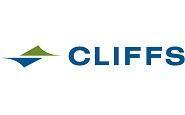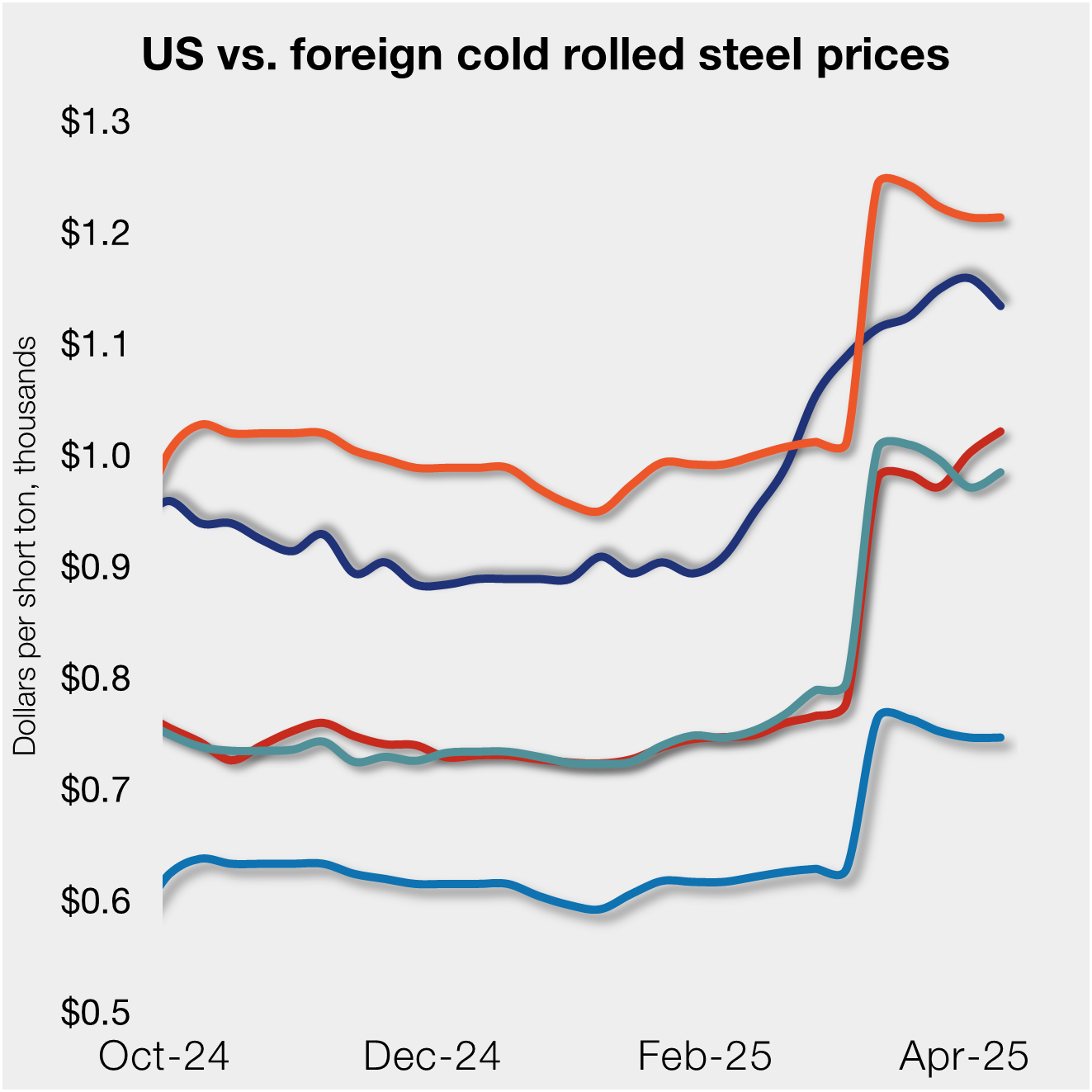Steel Products

Section 232, High Prices Should Not Slow Infrastructure Momentum: Goncalves
Written by Michael Cowden
May 10, 2021
Record-high steel prices result not from Section 232 tariffs or industry consolidation but instead from uniquely strong supply-demand fundamentals, Cleveland-Cliffs’ top executive said. And an ambitious infrastructure package would go a long way toward keeping those fundamentals, and the resulting investment in the domestic steel industry, stronger for longer, he suggested.
“We in this country have been lagging so much in terms of infrastructure … that we are in need of pretty much everything right now,” Cleveland-Cliffs Chairman, President and CEO Lourenco Goncalves said during a conference call with reporters Monday.
![]() Goncalves was joined on the call by Steel Caucus Co-Chairmen Rep. Frank Mrvan (D-Ind.), whose northwest Indiana district includes the largest steelmaking hub in the U.S.
Goncalves was joined on the call by Steel Caucus Co-Chairmen Rep. Frank Mrvan (D-Ind.), whose northwest Indiana district includes the largest steelmaking hub in the U.S.
“There is a great sense of urgency to pass an infrastructure bill,” Mrvan said. “You create the demand, he (Goncalves) will make the investments to be able to meet that demand.”
What’s Section 232 Got to Do With It?
High prices and tariffs on foreign steel are no obstacle to meeting the demand that would be stimulated by infrastructure spending, Goncalves said.
“It’s easy to single out something as the culprit. And tariffs are great for that. ‘Oh, prices are high because of the tariffs.’ That’s not true,” Goncalves said. “It’s all supply-demand. We are having, post-Covid, an influx of demand that is unprecedented.”
Mrvan echoed Goncalves’ support for Section 232 tariffs, a policy rolled out in 2018 by the Republican Trump administration, which he said were necessary to create a “level playing field to compete in the global market.”
Goncalves initially indicated that the tariffs were not strictly necessary. “From a business standpoint, it’s not a must have. But we need to find ways to make sure that bad players will not be allowed to play the wrong way and take advantage of the American market and, even more important, the American worker,” he said.
With steel and raw material prices rising abroad, it’s unlikely that other countries would be able to export to the U.S. at competitive prices without resorting to dumping, accepting government subsidies or evading duties, Goncalves said.
Steel Market Update asked Goncalves and Mrvan whether easing Section 232 tariffs on the European Union, a traditional U.S. ally, might be acceptable.
The EU has threatened to double tariffs on June 1 on a broad array of US exports – including whiskey, motorcycles and orange juice if the U.S. does not lift the steel and aluminum tariffs.
Goncalves said European steelmakers, especially those dependent on the seaborne ore trade, would be unable to compete with U.S. steelmakers–especially given record high iron ore prices abroad. Many domestic steel producers, in contrast, own their own mines or scrap yards and so are insulated from swiftly rising raw material costs internationally.
ARTICLE CONTINUES BELOW
{loadposition reserved_message}
“We know that companies like Cleveland-Cliffs that produce our own pellets and are self-sufficient, we have the lowest cost possible in this business. So I don’t see anyone who, once tariffs are removed, can be competitive here. They can dump again. But they can’t be competitive here. So let’s face it, the problem is not in the tariffs,” he said.
But citing the complexity of U.S.-EU negotiations, Goncalves stopped short of suggesting Section 232 be removed. “It’s better not to touch. If you touch here, you are going to create a problem over there. So I would keep it as is,” he said.
Mrvan agreed. “I am always listening to every point of view,” he said. “But ultimately I agree with Lourenco, you have to reward the good producers and the (good) actors within the industry.”
Build Demand and the Jobs Will Come
Goncalves brushed aside suggestions that high steel prices might be the result of steel industry consolidation. He pointed to the shutdown of nearly all domestic automotive production in late March and early April 2020 in response to the initial outbreak of the COVID-19 pandemic as a more likely culprit.
“That never happened before. Not even during WWII. … When everyone shuts down at the same time, that creates disruptions, and the system will try to self-correct and self-protect. And then when things come back, they never come back as planned, they come back as they can,” he said.
Cliffs is now running its steel mills at capacity (something backed up by SMU’s blast furnace status chart), hiring workers, and restarting previously idled facilities – such as its Columbus Coatings galvanizing plant in Ohio – to keep up with the demand, Goncalves noted.
And he chided buyers for not loading up on steel earlier when supply was plentiful at prices substantially lower.
SMU’s benchmark hot-rolled coil price was at $1,500 per ton ($75/cwt) when this article was filed, up 52.3% from $985 per ton at the beginning of the year and more than triple a 2020 low, recorded in August, of $440 per ton. Hot-rolled coil lead times meanwhile average 9.81 weeks, up 24.7% from 7.87 weeks in early January and more than double 3.67 weeks in early August, per SMU pricing and lead time archives.
“We are in a situation now where, one, everybody wants steel. … and, two, everybody wants the steel now. And that’s because they did not prepare and build inventories during the COVID times when prices were very low,” Goncalves said.
He also questioned whether high prices were a net negative for the steel industry, noting that “everybody is making a lot of money” and that “we have no inflation.”
High prices in addition mean that steelmakers likes Cliffs have the money to reinvest not only to keep plants up to date, but also to make the significant capital outlays necessary to keep up with aggressive decarbonization goals.
“We want to have this company that we acquired, all these plants that we acquired, to be growing. And they are growing, we are hiring people,” he said in reference to Cliffs’ acquisition of the former AK Steel and ArcelorMittal USA.
Cliffs, for example, has big plans for its Burns Harbor steelmaking complex in northwest Indiana – including increasing environmental protections, providing better support equipment for its blast furnaces, and installing a walking beam furnace for its hot-strip mill. “We have a series of big investments coming, on the way, for Burns Harbor. It’s one of our flagship plants and will be upgraded in the next 2-3 years,” Goncalves said.
And he noted that the mill is key in Cliffs’ portfolio when it comes to products such as light-gauge flat rolled steel and plate – the latter of which should see increased demand, assuming infrastructure spending results in investment in renewables such as offshore wind farms.
“We prepared to support whatever final shape or form the infrastructure bill will have,” he said. “There is a lot of negotiation happening in Congress. But with people like Congressmen Frank Mrvan involved I know that, in the end, things will go in the right direction.”
Mrvan said he would like to see the infrastructure bill focus on roads, bridges, waterways, water transmission systems, ports and airports – all of it made from American steel. And he stressed that doing so would pay social dividends as well.
“That is what infrastructure is all about. It is not only creating, investing in the infrastructure, but it’s investing in the American manufacturing base and the American worker,” he said. “And that’s why I have a sense of urgency toward it.”
Mrvan said he didn’t want the debate about infrastructure spending to get bogged down in debates about what constitutes physical infrastructure versus social infrastructure given that the two issues are interlinked and that such discussions have in the past slowed the momentum necessary to pass an ambitious bill.
“For forty years we have talked about an infrastructure bill. … And so I don’t want to get caught up in the weeds,” he said. “We are getting through a pandemic and an economic crisis, so my priority is to make sure that we finally put forward a piece of legislation.”
Just as gridlock has too often characterized Washington, so too have low prices been seen as acceptable in the U.S. steel industry, Goncalves said. “Prices that were artificially depleted by circumvention, dumping, countervailing, things like that, that was not the norm. This was the absurd that we had before consolidation and (before) an administration that is a lot more focused on the right things in terms of generating real jobs and generating economic development that is sustainable,” he said.
By Michael Cowden, Michael@SteelMarketUpdate.com
For those interested in the future of Section 232 and in infrastructure, join SMU’s Community Chat on Wednesday, May 12, at 11 am ET, where Brett Smith, senior director of government relations at the American Iron and Steel Institute (AISI), will be the featured speaker.
Lourenco Goncalvels will be a keynote speaker at this year’s SMU Steel Summit Conference in Atlanta on August 23-25. You can find more details here.

Michael Cowden
Read more from Michael CowdenLatest in Steel Products

AISI: Raw steel production levels off near six-month high
The volume of raw steel produced by US mills remained relatively flat last week, maintaining the rebound seen one week prior, according to the American Iron and Steel Institute (AISI). Previously at the second-highest rate of the year, production continues to hold at one the strongest levels recorded over the last six months.

Nucor keeps HRC price unchanged
Nucor has kept its weekly hot-rolled (HR) coil price flat this week, after a marginal cut the previous week.

SMU flat-rolled market survey results now available
SMU’s latest steel buyers market survey results are now available on our website to all premium members. After logging in at steelmarketupdate.com, visit the pricing and analysis tab and look under the “survey results” section for “latest survey results.” Past survey results are also available under that selection. If you need help accessing the survey results, or if […]

CRU tariff webinar replay now available
CRU’s latest webinar replay on how Trump’s tariffs affect the global steel market is now available on our website to all members. After logging in at steelmarketupdate.com, visit the community tab and look under the “previous webinars” section of the dropdown menu. You’ll find not only this special CRU webinar but also all past Community […]

US, offshore CRC prices diverge
US cold-rolled (CR) coil prices declined this week, slipping for the first time since early February. Most offshore markets deviated, moving higher this week.
